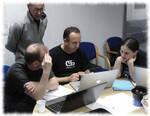DtCyber
DtCyber is a high fidelity simulator of Control Data 6000, 70, 170, and 700, series supercomputers. This version of DtCyber is a direct derivative of Desktop CYBER 5.5.1 created by Tom Hunter. This version simulates additional types of peripheral I/O devices, includes additional networking features, and supports the Nostalgic Computing Center. This repository also provides automation and artifacts intended to make it easy for anyone to build the simulator and run historic software on it.
Visit these subdirectories and repositories to find artifacts and information enabling you to install various operating systems on DtCyber after building it:
- COS : the Chippewa Operating System (COS) was one of the first operating systems created by Control Data for CDC 6000 series computer systems.
- HUSTLER : a derivative of the SCOPE operating system implemented and originally deployed at Michigan State University.
- KRONOS2.1 : KRONOS 2.1 was the logical ancestor of NOS 1 and a logical descendent of COS. It supports interactive access and batch operation.
- NOS1.3 : the NOS 1.3 operating system was a logical descendent of KRONOS. The instance provided here supports interactive access, local and remote batch operation, and a version of PLATO.
- NOS2.8.7 : NOS 2.8.7 was the last operating system formally released by CDC for its Cyber 170 series supercomputers. In addition to supporting interactive access and local and remote batch operation, the instance provided here supports a very rich collection of programming languages and data communication features.
- NOS/BE : the NOS/BE operation system was a descendent of COS and SCOPE. It was designed primarily for batch operation but also supported interactive access. Additional documentation about building a NOS/BE system can be found here on the CDC Community site, and a ready-to-run NOS/BE package can be found here.
Information about configuring and operating DtCyber can be found here on the CDC Community site.
Visit the CDC documentation archives at Bitsavers for a wealth of preserved documentation on Control Data hardware and software. In particular, the scans contributed by Tom Hunter provide a wealth of information about the CDC 6000, 70, 170, and 700 series machines and the software that ran on them (and continues to run on DtCyber).
Building the simulator
This root directory contains the source code for the simulator and makefiles for many types of machines and operating systems that can host it. Some of the most commonly used ones are:
- Makefile.linux32 A makefile for 32-bit Linux systems that produces a 32-bit DtCyber executable.
- Makefile.linux64 A makefile for Linux systems that produces a 64-bit DtCyber executable.
- Makefile.linux64-armv8 A makefile for ARM-based Linux systems (e.g., Raspberry Pi running 32-bit OS) that produces a 64-bit executable.
- Makefile.linux64-armv8-a A makefile for ARM-based Linux systems running a 64-bit OS (e.g., Raspberry Pi4 running 64-bit Linux) that produces a 64-bit executable.
- Makefile.macosx A makefile for 64-bit, Intel-based MacOS systems.
Project (DtCyber.vcxproj) and solution definition (DtCyber.sln) files are provided for Microsoft Visual Studio too.
For example, to build the simulator on MacOS, execute the following command:
make -f Makefile.macosx all
The all target builds dtcyber (the mainframe simulator) and various supporting tools and helper programs. You should specify the all target the very first time you run make, especially if you intend to run installers for the operating systems mentioned above. This will ensure that supporting tools are installed and initialized properly. Thereafter, if you want to build only the dtcyber executable, execute either of the following commands:
make -f Makefile.macosx dtcyber
make -f Makefile.macosx
To build dtcyber on Windows, open the solution file (DtCyber.sln) in Visual Studio and build the project defined by it.
Additional per platform build information (Linux, OSX, Raspberry Pi) is in BUILDING.README.txt.
Contributing
See CONTRIBUTING.md for information about contributing new features, enhancements, and bug fixes to the simulator.
 DokuWiki is a popular choice when choosing a Wiki software and has many advantages over similar software.
DokuWiki is a popular choice when choosing a Wiki software and has many advantages over similar software. Wikis are quick to update and new pages are easily added. Designed for collaboration while maintaining a history of every change, DokuWiki could be used as
Wikis are quick to update and new pages are easily added. Designed for collaboration while maintaining a history of every change, DokuWiki could be used as We support customization on all levels of expertise. From easy configuration via the admin interface through downloading of templates and plugins to developing your own extensions.
We support customization on all levels of expertise. From easy configuration via the admin interface through downloading of templates and plugins to developing your own extensions. A part of OpenSource is giving back to the community by getting involved. There are numerous options to do that.
A part of OpenSource is giving back to the community by getting involved. There are numerous options to do that.
